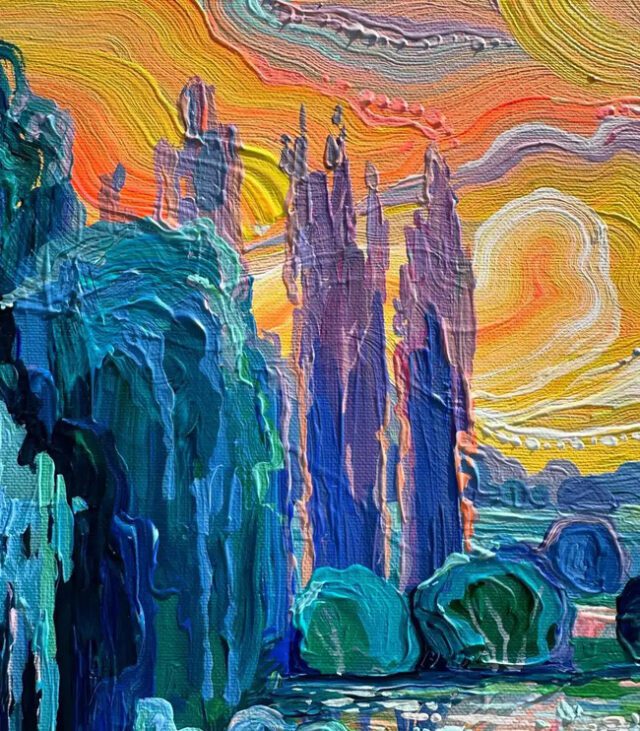
A year after the devastating fire in August, which ravaged Maui and severely damaged Lahaina, the town’s beloved 151-year-old Banyan Tree shows signs of resilience. The fire, which claimed over 100 lives and decimated much of the island’s landscape, left the Banyan Tree’s future uncertain. However, dedicated efforts by arborists to save the historic tree have begun to bear fruit—literally. Despite losing about half of its branches, particularly Continue reading “Here’s How Lahaina’s 151-Year-Old Banyan Tree Is Doing a Year After the Devastating Fire” »

Anastasia Trusova’s impasto paintings serve as a vibrant homage to her rural childhood in Russia, where the simplicity of life was intertwined with the rich beauty of nature. Using thick layers of brightly colored acrylics, Trusova creates dreamlike landscapes that evoke the lushness of forests, meadows, and lakes from her youth. These nature-inspired scenes, with their bold textures and vivid hues, are a modern reinterpretation of classic impressionist styles, reminiscent of masters like Monet and van Gogh. Trusova’s early life in a small town, surrounded by the tranquility of rural landscapes, deeply influences her art, where each stroke of paint seems to capture the essence of those cherished memories.

Now residing in Belgium, Trusova has fully embraced her artistic passion, dedicating herself to a style she describes as “textured graphic impressionism.” Through her work, she aims to convey the ever-changing beauty of nature, using techniques that bring her childhood memories to life on canvas. Trusova’s paintings not only reflect her connection to the past but also express a poignant message about the disappearing rural way of life. She hopes to preserve these scenes for future generations, instilling in them a sense of appreciation for the natural world that shaped her upbringing. Her art becomes a bridge between the past and the present, capturing fleeting moments of rural beauty that might otherwise be lost to time.
















As Halloween and Christmas approach, fans of “The Nightmare Before Christmas” have a new reason to celebrate. LEGO® is releasing a special LEGO® Ideas set that beautifully combines the spooky charm of Halloween with the festive spirit of Christmas, making it a perfect addition for those who adore Tim Burton’s 1993 stop-motion animated classic. This highly anticipated diorama set includes three iconic locations from the movie: the eerie Spiral Hill, Jack Skellington’s quirky house, and the Halloween Town Hall, each meticulously designed with authentic details that will transport fans straight into the whimsical world of the film. The set also comes with eight character mini-figures, including Jack Skellington, Sally, and even a brick-built version of the two-faced Mayor, adding a delightful touch for collectors and enthusiasts alike.

With 2,193 pieces, this LEGO® set is more than just a toy—it’s a collector’s item that captures the essence of “The Nightmare Before Christmas.” The set is perfect for adult fans who will appreciate the intricate details, like Jack’s Christmas formula on a chalkboard and the walking bathtub from the movie. Priced at $200, it’s a premium set that reflects the quality and attention to detail LEGO® is known for, making it a must-have for those who want to bring a bit of Halloween Town into their homes this holiday season. Plus, the LEGO Builder app offers 3D viewing tools to enhance the building experience, making it an even more immersive way to relive the magic of this beloved film.







One key to the success of the U.S. Women’s Gymnastics team at recent competitions, including their impressive haul of eight medals, is Beacon, a golden retriever who provides emotional support to the athletes. While much of the spotlight is on Simone Biles’ extraordinary performances, Beacon’s calming presence has played a vital role in managing the team’s pre-performance anxiety. His constant availability for petting and companionship has become Continue reading “One Key to Success For U.S. Women’s Gymnastics Team Is a Support Dog to Calm Nerves” »

Trees, much like humans, have developed mechanisms to protect themselves from the harmful effects of wildfire smoke. A study by MJ Riches and Delphine Farmer from Colorado State University reveals that trees essentially “hold their breath” during wildfires to avoid inhaling toxic particles and gases. Trees possess stomata, small pores on their leaves, that normally facilitate the exchange of gases—taking in carbon dioxide and releasing oxygen. However, when exposed to heavy smoke, these pores shut down completely, halting photosynthesis and reducing the emission of volatile organic compounds. This response is similar to how humans might stop breathing in a hazardous environment to avoid inhaling harmful substances.

The research, which occurred unexpectedly during a smoky day in the Rocky Mountains, found that even when the smoke cleared, the trees did not immediately resume their normal functions. The scientists had to intervene by adjusting the leaves’ temperature and humidity to restart their gas exchange processes. This discovery is crucial as it sheds light on how trees, and potentially other plants, might be coping with the increasing intensity and frequency of wildfires driven by climate change. While this protective mechanism helps trees survive the immediate threat, the long-term effects of repeated smoke exposure remain uncertain, highlighting the need for further research to understand and mitigate the impact on forests and agriculture.



The recent opening of the 2,000-year-old “Tomb of Cerberus” in Naples, Italy, has unveiled fascinating insights into the lives and burial practices of an ancient Roman family. Discovered in 2023 near Giugliano, this well-preserved tomb is adorned with elaborate frescoes depicting Cerberus, the mythical three-headed dog, and ichthyocentaurs, suggesting the high status of those interred. The tomb’s lavish design, featuring three altars and funeral beds, Continue reading “2,000-Year-Old ‘Tomb of Cerberus’ Coffin Is Cracked Open in Italy” »

The Strandvejen 35 Summer House at Følle Strand, Denmark, is a stunning example of how modern architecture can harmonize with nature. Drawing inspiration from the traditional fisherman’s houses in the area, this compact yet luxurious summer house covers only 46 square meters. Despite its modest size, the house offers ample space for up to seven guests, utilizing three interconnected buildings that maximize both functionality and aesthetic appeal. Each structure is thoughtfully positioned to provide breathtaking views of Kalø Bay, with large windows and walkways designed to blend indoor and outdoor living seamlessly. The use of sliding doors and strategic skylights enhances the feeling of openness while maintaining a cozy atmosphere, making it an ideal retreat for those who dream of escaping to nature.

Sustainability is at the heart of the Strandvejen 35 Summer House’s design. Locally sourced materials, particularly Danish oak, are used throughout the construction, from the facades to the roof, ensuring that the house not only complements its natural surroundings but also minimizes its environmental impact. The house is classified under Denmark’s voluntary low-emission category, highlighting its commitment to reducing CO2 emissions. The high ceilings and abundant natural light contribute to a healthy indoor environment, while the built-in benches and sofas offer a perfect spot to relax and take in the serene landscape. This summer house is a testament to how thoughtfully designed spaces can bring you closer to nature while providing all the comforts of a modern home.














The Roba is a futuristic kitchen air purifier designed to tackle the common problem of smoke and odors during cooking, especially in homes without built-in exhaust systems or kitchen hoods. Shaped like a sleek robot, this device is engineered to sit close to your induction stove, absorbing smoke and harmful particles as you cook. Its compact size and powerful functionality make it an ideal solution for small kitchens, where space is often at a premium. The Roba’s design includes two thin metal legs that stand at a 90-degree angle, providing stability and allowing it to remain near the stove. This proximity ensures that it effectively captures smoke and other contaminants before they can spread throughout the kitchen.

What sets the Roba apart is its flexible design, which allows it to adjust to different cooking scenarios. With a height-adjustable pillar and a rotating, bending head, the Roba can adapt its position as needed, ensuring optimal performance regardless of the dish you’re preparing. The device’s “friendly look” makes it a stylish addition to modern kitchens, blending seamlessly with contemporary decor. Although currently a concept, the Roba has the potential to become an essential kitchen appliance, particularly for those in smaller living spaces. Its robot-like appearance not only adds a touch of charm but also hints at the advanced technology inside, making it an appealing choice for tech-savvy home cooks looking to enhance their kitchen environment.













The Aalto desk concept exemplifies the innovative use of minimalist design to enhance functionality and aesthetics. Incorporating wave-like forms into the desk’s structure eliminates the need for traditional storage solutions like drawers, which are prone to wear and can obstruct visibility. The undulating shapes carved into the desk create natural compartments for organizing various items, offering both ease of access and visual appeal. The transparent tabletop, made from glass or polycarbonate, allows users to instantly see the contents of these compartments, making it easy to find and retrieve items without the hassle of opening drawers. This clever design merges form and function, providing a streamlined workspace that is both practical and elegant.

Additionally, the Aalto desk design addresses the common issues of clutter and space management by offering different variations tailored to user needs. One variant, featuring shorter and more uniform waves, minimizes the risk of users bumping their knees, while also encouraging a more organized approach to storage. Though this design slightly reduces the flexibility of storage space, it introduces a built-in organizational system that helps maintain a tidy desk. The inclusion of a side shelf in this variant adds further versatility, allowing for additional storage without compromising the minimalist aesthetic. Overall, the Aalto desk concept demonstrates how thoughtful design can solve practical problems while maintaining simplicity and style.






































































































